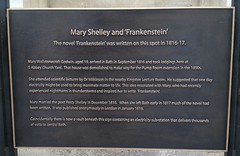

Frankenstein
(1816-present)
thing and novel
Aged 208
Wikidata WikipediaFrankenstein; or, The Modern Prometheus is an 1818 novel written by English author Mary Shelley. Frankenstein tells the story of Victor Frankenstein, a young scientist who creates a sapient creature in an unorthodox scientific experiment. Shelley started writing the story when she was 18, and the first edition was published anonymously in London on 1 January 1818, when she was 20. Her name first appeared in the second edition, which was published in Paris in 1821. Shelley travelled through Europe in 1815, moving along the river Rhine in Germany, and stopping in Gernsheim, 17 kilometres (11 mi) away from Frankenstein Castle, where, two centuries before, an alchemist had engaged in experiments. She then journeyed to the region of Geneva, Switzerland, where much of the story takes place. Galvanism and occult ideas were topics of conversation for her companions, particularly for her lover and future husband Percy B. Shelley. In 1816 Mary, Percy and Lord Byron had a competition to see who could write the best horror story. After thinking for days, Shelley was inspired to write Frankenstein after imagining a scientist who created life and was horrified by what he had made. Though Frankenstein is infused with elements of the Gothic novel and the Romantic movement, Brian Aldiss has argued for regarding it as the first true science-fiction story. In contrast to previous stories with fantastical elements resembling those of later science fiction, Aldiss states, the central character "makes a deliberate decision" and "turns to modern experiments in the laboratory" to achieve fantastic results. The novel has had a considerable influence on literature and on popular culture; it has spawned a complete genre of horror stories, films, and plays. Since the publication of the novel, the name "Frankenstein" has often been used, erroneously, to refer to the monster, rather than to his creator/father.
DbPedia
Commemorated on 1 plaque
Mary Shelley and 'Frankenstein'. The novel 'Frankenstein' was written on this spot in 1816-17. Mary Wollstonecraft Godwin, aged 19, arrived in Bath in September 1816 and took lodgings here at 5 Abbey Church Yard. That house was demolished to make way for the Pump Room extension in the 1890s. She attended scientific lectures by Dr Wilkinson in the nearby Kingston Lecture Room. he suggested that one day electricity might be used to bring inanimate matter to life. this idea resonated with Mary, who had recently experienced nightmares in thunderstorms and inspired her to write 'Frankenstein'. Mary married the poet Percy Shelly in December 1816. When she left Bath early in 1817 much of the novel had been written. It was published anonymously in London in January 1818. Coincidentally there is now a vault beneath this sign containing an electricity sub-station that delivers thousands of volts to central Bath.
The Pump Room, Abbey Chambers, Bath, United Kingdom where it was written (1816-1817)
